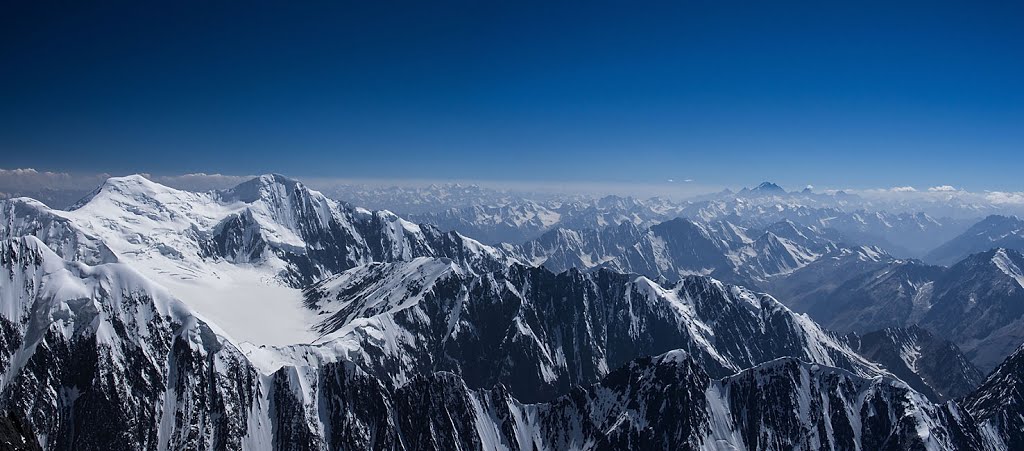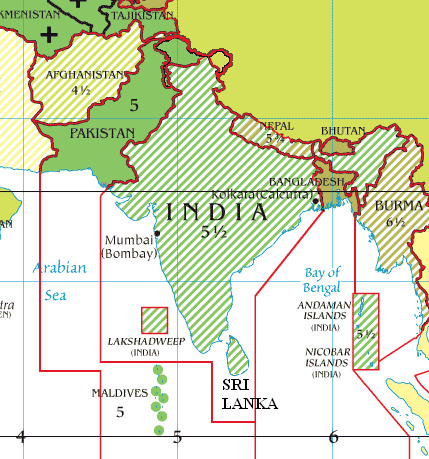|
Qalʽeh-ye Panjeh
Qaleh-ye Panjeh ( fa, قلعه پنجه), also written Qila-e Panjeh and Kala Panja, is a village in Wakhan, Badakhshan Province in north-eastern Afghanistan. It lies on the Panj River, near the confluence of the Wakhan River and the Pamir River. Qaleh-ye Panjeh was once the capital of the Mirdom of Wakhan. Near the village is the former hunting lodge of Zahir Shah, the last king of Afghanistan. The village also contains the holy shrine of Panja Shah. The village is inhabited by Wakhi people. The population of the village (2003) is 640. In July 2021 the village was captured by the Taliban. See also *Badakhshan Province Badakhshan Province (Persian/ Uzbek: , ''Badaxšān'') is one of the 34 provinces of Afghanistan, located in the northeastern part of the country. It is bordered by Tajikistan's Gorno-Badakhshan in the north and the Pakistani regions of Lower ... References External linksSatellite map at Maplandia.com Populated places in Badakhshan Province Wakha ... [...More Info...] [...Related Items...] OR: [Wikipedia] [Google] [Baidu] |
Provinces Of Afghanistan
Afghanistan is divided into 34 provinces (, '' wilåyat''). The provinces of Afghanistan are the primary administrative divisions. Each province encompasses a number of districts or usually over 1,000 villages. Provincial governors played a critical role in the reconstruction of the Afghan state following the creation of the new government under Hamid Karzai. According to international security scholar Dipali Mukhopadhyay, many of the provincial governors of the western-backed government were former warlords who were incorporated into the political system. Provinces of Afghanistan Regions of Afghanistan UN Regions Former provinces of Afghanistan During Afghanistan's history it had a number of provinces in it. It started out as just Kabul, Herat, Qandahar, and Balkh but the number of provinces increased and by 1880 the provinces consisted of Balkh, Herat, Qandahar, Ghazni, Jalalabad, and Kabul. * Southern Province – dissolved in 1964 to create Paktia Provinc ... [...More Info...] [...Related Items...] OR: [Wikipedia] [Google] [Baidu] |
Badakhshan Province
Badakhshan Province (Persian/ Uzbek: , ''Badaxšān'') is one of the 34 provinces of Afghanistan, located in the northeastern part of the country. It is bordered by Tajikistan's Gorno-Badakhshan in the north and the Pakistani regions of Lower and Upper Chitral and Gilgit-Baltistan in the southeast. It also has a 91-kilometer (57-mile) border with China in the east. It is part of a broader historical Badakhshan region, parts of which now also lie in Tajikistan and China. The province contains 22 districts, over 1,200 villages and approximately 1 055 00people. Fayzabad, Badakhshan, Fayzabad serves as the provincial capital. Resistance activity has been reported in the province since the 2021 Taliban takeover of Afghanistan. Etymology Badakhshan's name comes from the Middle Persian word "badaxš", which is an official title. The word "ān" is a suffix which demonstrates a place's name; therefore the word "badaxšān" means a place belonging to a person called "badaxš". Duri ... [...More Info...] [...Related Items...] OR: [Wikipedia] [Google] [Baidu] |
Time In Afghanistan
Time in Afghanistan is officially UTC+04:30, called Afghanistan Time or AFT. Afghanistan does not observe daylight saving time. IANA time zone database Afghanistan has the IANA time zone database The tz database is a collaborative compilation of information about the world's time zones, primarily intended for use with computer programs and operating systems. Paul Eggert is its current editor and maintainer, with the organizational backi ... time zone "Asia/Kabul". References {{afghanistan-stub ru:Афганистан#Время в Афганистане ... [...More Info...] [...Related Items...] OR: [Wikipedia] [Google] [Baidu] |
Village
A village is a clustered human settlement or community, larger than a hamlet but smaller than a town (although the word is often used to describe both hamlets and smaller towns), with a population typically ranging from a few hundred to a few thousand. Though villages are often located in rural areas, the term urban village is also applied to certain urban neighborhoods. Villages are normally permanent, with fixed dwellings; however, transient villages can occur. Further, the dwellings of a village are fairly close to one another, not scattered broadly over the landscape, as a dispersed settlement. In the past, villages were a usual form of community for societies that practice subsistence agriculture, and also for some non-agricultural societies. In Great Britain, a hamlet earned the right to be called a village when it built a church. [...More Info...] [...Related Items...] OR: [Wikipedia] [Google] [Baidu] |
Wakhan
Wakhan, or "the Wakhan" (also spelt Vakhan; Persian and ps, واخان, ''Vâxân'' and ''Wāxān'' respectively; tg, Вахон, ''Vaxon''), is a rugged, mountainous part of the Pamir, Hindu Kush and Karakoram regions of Afghanistan. Wakhan District is a district in Badakshan Province. Geography The Wakhan is located in the extreme north-east of Afghanistan. It contains the headwaters of the Amu Darya (Oxus) River, and was an ancient corridor for travellers from the Tarim Basin to Badakshan. The geographic position of Wakhan between China, India, and Bactria allowed it to play a major role in trade in the ancient world. Until 1883, the Wakhan included the whole valley of the Panj River and the Pamir River, as well as the upper flow of the Panj River known as the Wakhan River. An 1873 agreement between UK and Russia split the Wakhan by delimiting spheres of influence for the two countries at the Panj and Pamir rivers. [...More Info...] [...Related Items...] OR: [Wikipedia] [Google] [Baidu] |
Afghanistan
Afghanistan, officially the Islamic Emirate of Afghanistan,; prs, امارت اسلامی افغانستان is a landlocked country located at the crossroads of Central Asia and South Asia. Referred to as the Heart of Asia, it is bordered by Pakistan to the Durand Line, east and south, Iran to the Afghanistan–Iran border, west, Turkmenistan to the Afghanistan–Turkmenistan border, northwest, Uzbekistan to the Afghanistan–Uzbekistan border, north, Tajikistan to the Afghanistan–Tajikistan border, northeast, and China to the Afghanistan–China border, northeast and east. Occupying of land, the country is predominantly mountainous with plains Afghan Turkestan, in the north and Sistan Basin, the southwest, which are separated by the Hindu Kush mountain range. , Demographics of Afghanistan, its population is 40.2 million (officially estimated to be 32.9 million), composed mostly of ethnic Pashtuns, Tajiks, Hazaras, and Uzbeks. Kabul is the country's largest city and ser ... [...More Info...] [...Related Items...] OR: [Wikipedia] [Google] [Baidu] |
National Geospatial Intelligence Agency
The National Geospatial-Intelligence Agency (NGA) is a combat support agency within the United States Department of Defense whose primary mission is collecting, analyzing, and distributing geospatial intelligence (GEOINT) in support of national security. Initially known as the National Imagery and Mapping Agency (NIMA) from 1996 to 2003, it is a member of the United States Intelligence Community. NGA headquarters, also known as NGA Campus East or NCE, is located at Fort Belvoir North Area in Springfield, Virginia. The agency also operates major facilities in the St. Louis, Missouri area (referred to as NGA Campus West or NCW), as well as support and liaison offices worldwide. The NGA headquarters, at , is the third-largest government building in the Washington metropolitan area after The Pentagon and the Ronald Reagan Building. In addition to using GEOINT for U.S. military and intelligence efforts, NGA provides assistance during natural and man-made disasters, aids in security ... [...More Info...] [...Related Items...] OR: [Wikipedia] [Google] [Baidu] |
Panj River
The Panj (russian: Пяндж; fa, رودخانه پنج) (; tg, Панҷ, پنج), traditionally known as the Ochus River and also known as ''Pyandzh'' (derived from its Russian name "Пяндж"), is a tributary of the Amu Darya. The river is long and has a basin area of .Пяндж (река) It forms a considerable part of the – border. The river is formed by the ... [...More Info...] [...Related Items...] OR: [Wikipedia] [Google] [Baidu] |
Wakhan River
Wakhan River ( prs, اب واخان; ps, واخان سیند); known locally as ''Ab-i-Wakhan'' or ''Abe Vâxân'', ''Вахондарё'' and ''Vaxondaryo'') is the name of the Sarhadd branch of the Panj River along its upper length in the Wakhan District of Badakhshan Province of Afghanistan. The river arises in the Hindu Kush. It is formed by the confluence of the Wakhjir River and the Bozai River near Kashch Goz and Bozai Gumbaz, some 40 km west of the Wakhjir Pass. Shortly thereafter, the Little Pamir comes to an end, and the conjoined river contracts into a narrow, deep, rapid river, delimited by cliffs and steep hills. From here the banks have grown birch and juniper trees. 40 km west at Sarhad-e Broghil the river flows in a dramatic basin 3 km wide. [...More Info...] [...Related Items...] OR: [Wikipedia] [Google] [Baidu] |
Pamir River
The Pamir River is a shared river located in the Badakhshan Province of Afghanistan and in the Gorno-Badakhshan in Tajikistan. It is a tributary of the Panj River, and forms the northern boundary of Afghanistan's Wakhan District. The river has its sources in the Pamir Mountains in the far eastern part of Gorno-Badakhshan, Tajikistan. It flows between the Alichur mountain range in the north and the Wakhan District in the south. It starts from the Lake Zorkul, at a height of 4130 meters, and then flows towards the west, and later southwest. Near the town of Langar, at 2799 m, it joins the Wakhan River and forms the Panj River. The Pamir forms the boundary between Afghanistan and Tajikistan along its entire length. Northwest of Langar is the high Karl Marx Peak and Friedrich Engels Peak (). A road runs along the river on the Tajik side to Khargush where it turns north to join the Pamir Highway. A road of lower quality continues east past Zorkul, almost to the Chinese bord ... [...More Info...] [...Related Items...] OR: [Wikipedia] [Google] [Baidu] |
Mirdom Of Wakhan
The Mirdom of Wakhan (), Principality of Wakhan (), or the Khanate of Wakhan () was a semi-independent Wakhi principality in Central Asia that existed until 1883. It controlled both banks of the Upper Amu Darya and was governed by a hereditary chieftain known as a mir, with its capital at Qal'ah-yi Panjah. Background Wakhan had existed since the time of the Sasanian Empire when it was subjugated by the latter in 224 until 651 when the authority there collapsed. They were also subjugated by the Hephthalites, the First Turkic Khaganate, the Tibetan Empire, the Tang dynasty, the Samanid Empire, and later many Turko-Mongol khanates until their eventual subjugation by the Emirate of Afghanistan and the Russian Empire in the late 19th century. History Establishment and Early Years Nonetheless, Wakhan's origin story is obscure. According to local tradition, in 1581 four brothers from Iran travelled to Badakhshan to spread the Isma'ili doctrine and eventually settled in the regi ... [...More Info...] [...Related Items...] OR: [Wikipedia] [Google] [Baidu] |
Mohammed Zahir Shah
Mohammed Zahir Shah (Pashto/Dari: , 15 October 1914 – 23 July 2007) was the last king of Afghanistan, reigning from 8 November 1933 until he was deposed on 17 July 1973. Serving for 40 years, Zahir was the longest-serving ruler of Afghanistan since the foundation of the Durrani Empire in the 18th century. He expanded Afghanistan's diplomatic relations with many countries, including with both sides of the Cold War. In the 1950s, Zahir Shah began modernizing the country, culminating in the creation of a new constitution and a constitutional monarchy system. Demonstrating nonpartisanship, his long reign was marked by peace in the country that was lost afterwards. In 1973, while Zahir Shah was undergoing medical treatment in Italy, his regime was overthrown in a coup d'état by his cousin and former prime minister, Mohammed Daoud Khan, who established a single-party republic, ending more than 225 years of continuous monarchical government. He remained in exile near Rome until 2002 ... [...More Info...] [...Related Items...] OR: [Wikipedia] [Google] [Baidu] |






_Corridor.jpg)
